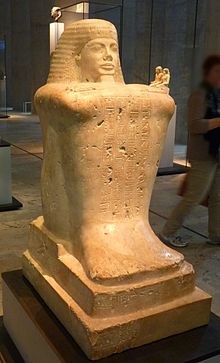Bakenkhons I
|
Bakenkhonsu High Priest of Amun |
|
|---|---|

Block statue of Bakenkhonsu at Munich.
|
|
| Successor | Roma called Roy |
| Dynasty | 19th Dynasty |
| Pharaoh | Ramesses II |
| Father | Ipui |
| Wife | Meretseger |
| Children |
Paser and Amenmesse Nefertari |
| Burial | Thebes |
Bakenkhonsu (“Servant of Khonsu”) was a High Priest of Amun in ancient Egypt during the reign of Pharaoh Ramesses II. Information about his life was found on the back of his statue (which is now located in Munich). The information on the statue provides details about the education of young Egyptian noblemen at that time and the career of priests.
Bakenkhonsu is named for the god Khonsu, traveller, a Moon God of Ancient Egypt and son of Amun.
According to the information inscribed on his statue, Bakenkhonsu was the son of Ipui, a priest of Amun (other sources suggest that he was the son of Roma, whose wife was also called Roma). His two younger brothers were Roma-Roi and Ipui. He spent four years at school, starting at the age of four, as was customary at that time. He then worked at the stables of Pharaoh Seti I for eleven years. There he learned to shoot with a bow and to drive a chariot. It is possible that he also served in the Pharaoh's army.
Bakenkhonsu's career as a priest then began when he joined Amun's priesthood in Thebes where his father already served as a priest (Ipui later became Second Prophet of Amun). Bakenkhonsu served as a wab priest (lowest priestly rank) for four years. He was then promoted to the rank of prophet and, twelve years later, he was the Third Prophet of Amun, the third highest ranking priest in the most powerful priesthood of the era. Later he was promoted to second, then to first prophet or high priest, a position he held for twenty-seven years. He died in the last regnal year of Ramesses II, at the age of ninety, and was succeeded as High Priest by his brother Roma-Roi.
Bakenkhonsu was responsible for several building projects for the king, including the eastern temple in the Karnak Temple complex.
...
Wikipedia
